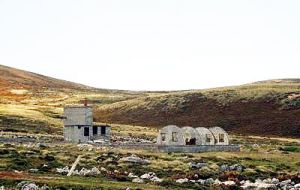MercoPress. South Atlantic News Agency
Falklands plans housing development on the site of a British camp from WWII
 The site to the west of Stanley, comprising 12.7 hectares of open land, contains the remnants of a British camp from the Second World War
The site to the west of Stanley, comprising 12.7 hectares of open land, contains the remnants of a British camp from the Second World War  Foundations and earthworks from the camp are still visible. Falklands Museum and National Trust are now involved in retaining as much heritage as possible.
Foundations and earthworks from the camp are still visible. Falklands Museum and National Trust are now involved in retaining as much heritage as possible. The Falkland Islands population is growing and equally significant future development prospects are encouraging, thus the need for more housing particularly in the capital Stanley. Working on this the Planning and Building Committee has approved a new residential housing development, ‘Phase 6 Sapper Hill’, to be allocated on Bennett’s Paddock, near where Ross Road West meets Moody Brook Road.
The committee gave the go-ahead to the plans after taking measures to allay community concerns over the new development.
The site to the west of Stanley, comprising 12.7 hectares of open land, contains the remnants of a British camp from the Second World War. Foundations and earthworks from the camp are still visible. Five letters were sent expressing dismay over the development, and the Falkland Islands Museum and National Trust is now involved in efforts to retain as much of this heritage as possible.
In their comments on the proposal, the museum gave the context for the establishment of the base on the Islands. Soon after the Japanese attack on Pearl Harbour in 1941, signals intelligence suggested that Japan was considering taking the Falkland Islands. Winston Churchill responded by ordering a task force to act as a deterrent, and so 1,840 men from the Prince of Wales’s Own (West Yorkshire) Regiment were housed in a new camp on the outskirts of Stanley.
The Falklands Force, also known as Force 122, lived in what was arguably the Second World War’s most remote British outpost, which included a field hospital, a theatre, a library, several chapels, laundry services, detention barracks, stables and a butchery.
“To our national shame,” the museum states in its response, “much of the rest of the site has been indiscriminately developed on and Bennett’s Paddock offers the last remaining opportunity to study and record the camp’s remains.”
The museum is now looking to carry out some basic artefact searches before and during the works, and will collate its findings into a published report, available to the public. It said that ideally one of the building remains should be preserved “as a focal point for heritage and remembrance.”
Other residents sent letters in response to the proposal, voicing apprehension concerning preservation of the camp, as well as the privacy of existing residents, flood risks and wider development impacts such as increased road traffic, sewage capacity, commercial uses and site conditions.
Head of Planning and Building Services Lee Kenebel, told the committee: “Development of the site will not prevent future study and deepening the understanding of the camp and its associations with World War Two. Many aspects of the site have already been recorded and an opportunity for further archaeological study of physical remains can be delivered.”
In his report, Mr Kenebel assured the committee: “The development shall not be occupied until the site investigation and post investigation assessment has been completed.” In addition, there are reports of yellow pale maidens among the grassland on the site, a protected plant in the Islands.
The plan there is to replant. “Discussions with the Environmental Officer confirm that it will be possible to trans-locate the species before site-wide work commences.”
Unfortunately, it’s only possible to locate the flowers once they bloom, so until then it is being assumed that any part of the site could harbour the species. In his conclusion, Mr Kenebel said: “The Falkland Islands Development Plan looks to deliver at least 362 homes over the plan period and this application will contribute to that.”
The development will feature footpaths on both sides of the road in an effort to give a more spacious feel, as opposed to the single footpath layout in evidence on other Sapper Hill streets.
“Housing tenure and the style of homes will be established in later applications,” said Mr Kenebel. “But there is an inherent flexibility in the site that gives it significant development potential to accommodate a wide variety of homes and meet a range of housing needs.” (Penguin News).




Top Comments
Disclaimer & comment rules-

-

-

Read all commentsEllis, Mel, Lu or whoever you call yourself.
Oct 17th, 2019 - 11:53 am +1Never in a month of Sundays.
England will return the Malvinas within 25 years.
Oct 17th, 2019 - 04:22 am -2England will return the Malvinas within 25 years.
Oct 15th, 2019 - 02:44 am -3Commenting for this story is now closed.
If you have a Facebook account, become a fan and comment on our Facebook Page!